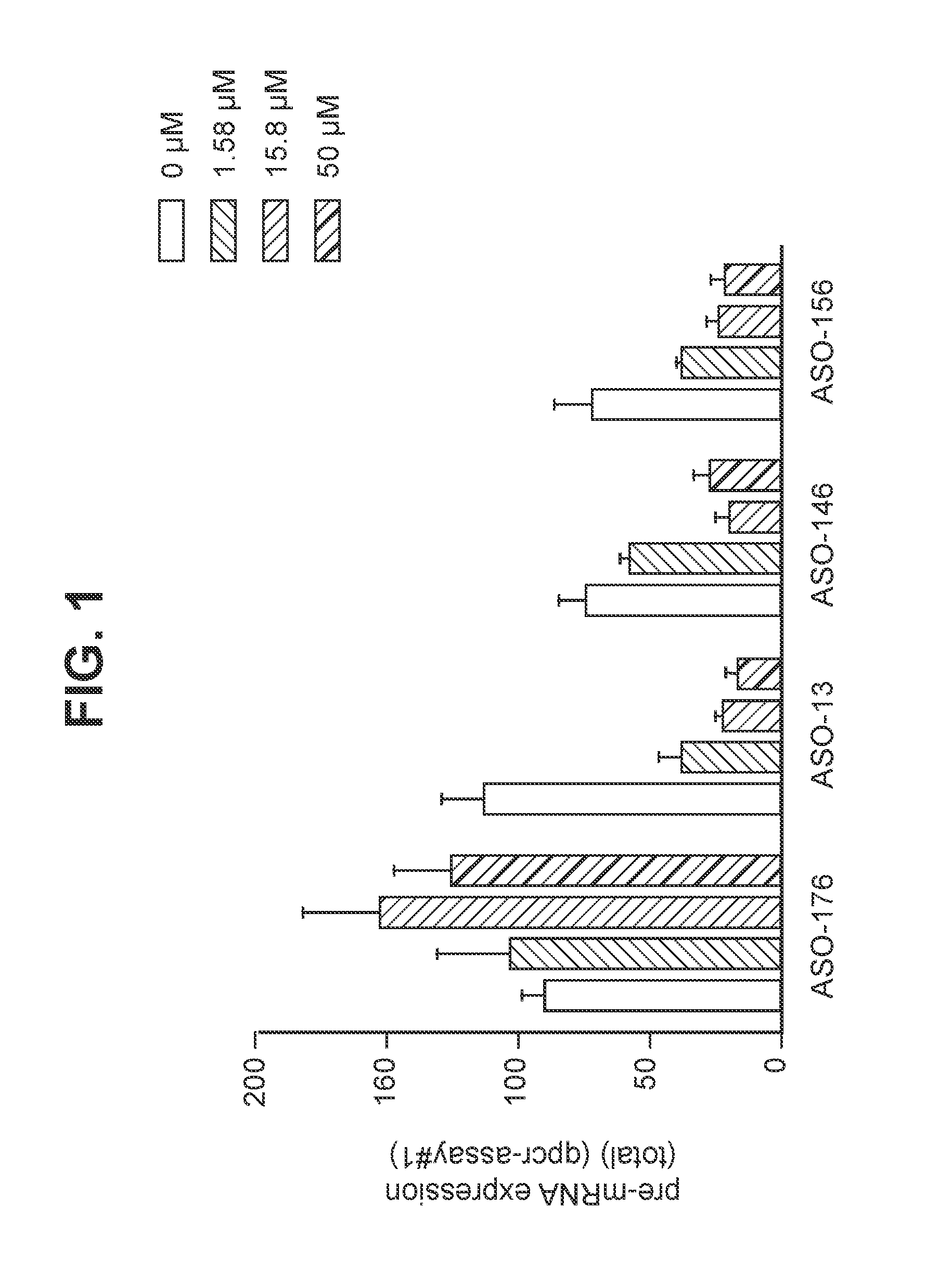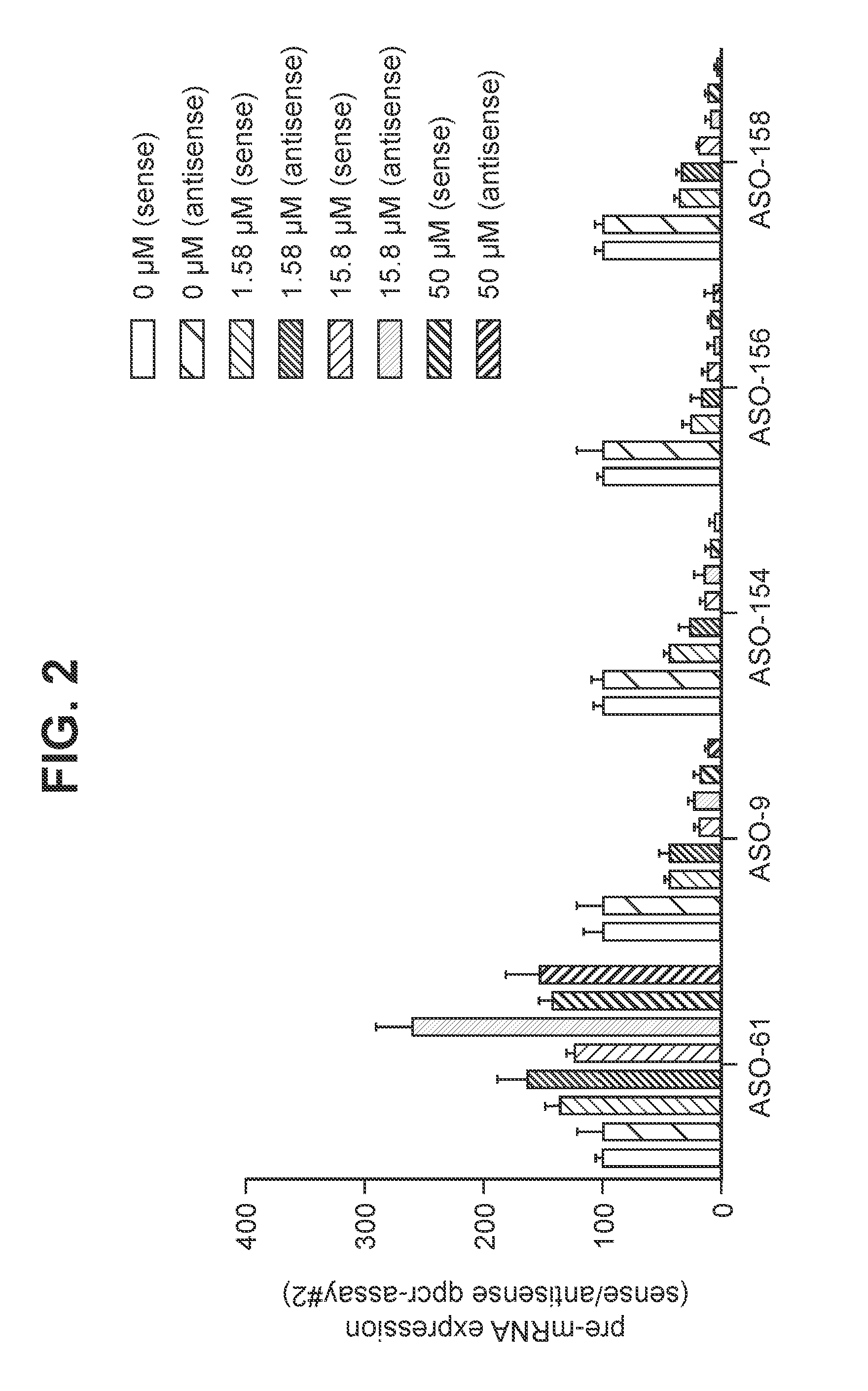Oligomers targeting hexanucleotide repeat expansion in human c9orf72 gene
a technology of c9orf72 and hexanucleotide repeats, applied in the field of oligomers targeting hexanucleotide repeat expansion in human c9orf72 gene, to achieve the effect of reducing the amount of rna transcribed and reducing the amount of one or the other
- Summary
- Abstract
- Description
- Claims
- Application Information
AI Technical Summary
Benefits of technology
Problems solved by technology
Method used
Image
Examples
example 1
Treatment with oligomers targeting C9ORF72 RNA
[0323]Materials and Methods:
[0324]Tissue Culture
[0325]Cells were cultured in the appropriate medium as described below and maintained at 37° C. at 95-98% humidity and 5% CO2. Cells were routinely passaged 1-2 times weekly.
[0326]ND40063:
[0327]Primary human skin fibroblast cells isolated from a 41 year old female subject with familial FTD / ALS contains a C9ORF72 gene with expanded hexanucleotide repeats. ND40063 cells were purchased from Coriell Institute for Medical Research. and cultured in DMEM (Sigma) with 15% FBS+100 units / ml penicillin (Gibco)+100 μg / ml streptomycin (Gibco).
[0328]HEK-293:
[0329]Human embryonic kidney cell line purchased from ATCC and cultured in DMEM (Sigma) with 10% FBS+100 units / ml penicillin (Gibco)+100 μg / ml streptomycin (Gibco).
[0330]Unassisted Oligomer Uptake in Cells (“Gymnotic Delivery”)
[0331]Cell culturing: ND40063 or HEK-293 cells were seeded in 24-well plates at 37° C. (5% CO2) in 0.5 ml growth medium supple...
example 2
Targeting Both Sense and Antisense C9orf72 RNA Strands with Oligomers
[0342]In accordance to the present disclosure, a series of oligomers were tested for their ability to simultaneously target both sense and antisense C9orf72 pre-mRNA strands. See Table 2: Oligomers are evaluated for their potential to knockdown sense or antisense C9orf72 pre-mRNA in human ND40063 cells following unassisted uptake. The results showed very potent down regulation of sense C9orf72 pre-mRNA (80-86%: ASO-9, ASO-154, ASO-156 and ASO-158) and antisense C9orf72 pre-mRNA (76-91%: ASO-9, ASO-154, ASO-156 and ASO-158) with 15.8 μM of all oligomers.
[0343]The structure and nucleobase sequence of the oligomers described in FIG. 2 and Table 2 are disclosed in Table 4 in which the oligomer numbers in the first column correspond to the numbers following the prefix “ASO-”.
[0344]Human ND40063 cells were treated with different oligomers that target the C9orf72-repeat expansion. After 3 days of oligomer treatment the le...
example 3
Potent Knock-Down in Cells Containing the C9orf72-Repeat Expansion
[0345]A series of oligomers were tested for their ability to specifically target and to knockdown mutant C9orf72 RNA (C9orf72-repeat expansion containing RNA). Table 3 shows how different oligomers specifically down regulate mutant C9orf72 RNA in ND40063 cells, but not wild-type C9orf72 RNA in HEK-293 cells. The results showed very potent down regulation of C9orf72 pre-mRNA in ND40063 cells (80-87%: ASO-127, ASO-144, ASO-145, ASO-146 and ASO-147) and a much milder effect on C9orf72 mRNA (33-44%: ASO-127, ASO-144, ASO-145, ASO-146 and ASO-147) at 25 μM concentration. There was no C9orf72 RNA knockdown observed using the same concentration of oligomer in HEK-293 cells.
[0346]The structure and nucleobase sequence of the oligomers described in FIG. 3 and Table 3 are disclosed in Table 4 in which the oligomer numbers in the first column correspond to the numbers following the prefix “ASO-”.
[0347]Human ND40063 and HEK-293 ce...
PUM
| Property | Measurement | Unit |
|---|---|---|
| time | aaaaa | aaaaa |
| humidity | aaaaa | aaaaa |
| humidity | aaaaa | aaaaa |
Abstract
Description
Claims
Application Information
 Login to View More
Login to View More - R&D
- Intellectual Property
- Life Sciences
- Materials
- Tech Scout
- Unparalleled Data Quality
- Higher Quality Content
- 60% Fewer Hallucinations
Browse by: Latest US Patents, China's latest patents, Technical Efficacy Thesaurus, Application Domain, Technology Topic, Popular Technical Reports.
© 2025 PatSnap. All rights reserved.Legal|Privacy policy|Modern Slavery Act Transparency Statement|Sitemap|About US| Contact US: help@patsnap.com



